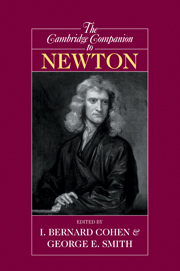Book contents
- Frontmatter
- Introduction
- 1 Newton's philosophical analysis of space and time
- 2 Newton's concepts of force and mass, with notes on the Laws of Motion
- 3 Curvature in Newton's dynamics
- 4 The methodology of the Principia
- 5 Newton's argument for universal gravitation
- 6 Newton and celestial mechanics
- 7 Newton's optics and atomism
- 8 Newton's metaphysics
- 9 Analysis and synthesis in Newton's mathematical work
- 10 Newton, active powers, and the mechanical philosophy
- 11 The background to Newton's chymistry
- 12 Newton's alchemy
- 13 Newton on prophecy and the Apocalypse
- 14 Newton and eighteenth-century Christianity
- 15 Newton versus Leibniz: from geometry to metaphysics
- 16 Newton and the Leibniz-Clarke correspondence
- Bibliography
- Index
3 - Curvature in Newton's dynamics
Published online by Cambridge University Press: 28 May 2006
- Frontmatter
- Introduction
- 1 Newton's philosophical analysis of space and time
- 2 Newton's concepts of force and mass, with notes on the Laws of Motion
- 3 Curvature in Newton's dynamics
- 4 The methodology of the Principia
- 5 Newton's argument for universal gravitation
- 6 Newton and celestial mechanics
- 7 Newton's optics and atomism
- 8 Newton's metaphysics
- 9 Analysis and synthesis in Newton's mathematical work
- 10 Newton, active powers, and the mechanical philosophy
- 11 The background to Newton's chymistry
- 12 Newton's alchemy
- 13 Newton on prophecy and the Apocalypse
- 14 Newton and eighteenth-century Christianity
- 15 Newton versus Leibniz: from geometry to metaphysics
- 16 Newton and the Leibniz-Clarke correspondence
- Bibliography
- Index
Summary
INTRODUCTION
The first edition of Isaac Newton's Principia was published in 1687, followed by a second edition in 1713 and a third in 1726, the year before he died. The Principia is universally held to have been a major turning point in natural philosophy in the seventeenth century. That turning point is clearly reflected in the comparison of the title of Descartes's 1644 Principles of Philosophy with the title of Newton's Mathematical Principles of Natural Philosophy. Even though both men were noted mathematicians, Newton's book is distinguished from that of Descartes by virtue of being a mathematical description of nature. In the General Scholium of the second edition Newton sets out the difference quite clearly: “But hitherto I have not been able to discover the cause of those properties of gravity from phenomena, and I frame no hypotheses . . . And to us it is enough, that gravity does exist, and acts according to the [mathematical] laws which we have explained.” Although Newton was strongly influenced by the Cartesian mechanical philosophy during the first two decades of his scholarly work, he nevertheless expressed himself analytically from the very beginning of his work in 1664. By 1684, however, he had rejected Cartesian mechanical explanations for gravity, and in the Principia he emphasized the analytical expression of the inversesquare law for gravity. The final impetus for that rejection came from Newton's correspondence in 1679 with Robert Hooke, which led Newton to derive Kepler's area law as a geometrical measure of time to employ in analyzing orbital motion. That same correspondence has shown that Newton's later work is an extension, not a revision, of his earlier work.
- Type
- Chapter
- Information
- The Cambridge Companion to Newton , pp. 85 - 137Publisher: Cambridge University PressPrint publication year: 2002
- 9
- Cited by



